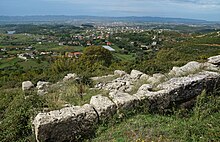Albanopolis
Ἀλβανόπολις | |
|---|---|
City | |
 | |
| Country | Roman Macedon |
| City | Epirus Nova |
41°28′31″N 19°46′35″E / 41.47528°N 19.77639°E




Albanopolis (Albanian: Albanopolis or Albanët; Ancient Greek: Ἀλβανόπολις, romanized: Albanópolis)[1][2] was a city in ancient Roman Macedon specifically in Epirus Nova, the city of the Albanoi, an Illyrian tribe. Albanopolis has been located by various scholars at the modern-day village of Zgërdhesh[3][4] or at Krujë.[5][6] The ancient city may correspond with later mentions of the settlement called Arbanon and Albanon during the Middle Ages, although it is not certain this was the same place.[7] The city appears in the literature in 150 AD, almost 300 years after Roman conquest of the region.
The city and its tribe gave their name to modern Albania.
Attestation
[edit]The toponym Albanopolis has been found on a funeral inscription in Gorno Sonje, near the city of Skopje (ancient Scupi), present-day North Macedonia.[8] It was discovered in 1931 by Nikola Vulić and its text was analyzed and published in 1982 by Borka Dragojević-Josifovska. The inscription in Latin reads "POSIS MESTYLU F[ILIUS] FL[AVIA] DELVS MVCATI F[ILIA] DOM[O] ALBANOP[OLI] IPSA DELVS". It is translated as "Posis Mestylu, son of Flavia, daughter of Delus Mucati, who comes from Albanopolis". It dates to the end of the 1st century or beginning of the 2nd century AD.[9]
Ptolemy (100-170 AD) is the only author who mentions Albanopolis. He mentions it in the third book of Geographia as a city of a tribe he refers to as the Albanoi.[10][11] They were a people who lived in the region between Mat and Shkumbin. Johann Georg von Hahn first noted that the suffix -polis ("city") was probably added at a later date by other authors as in other editions it is mentioned as "Albanos polis" or "Albanos".[10]
Location
[edit]The first scholar to advance the idea that Zgërdhesh was the site of the ancient Albanopolis was Austrian diplomat Johann Georg von Hahn. Zgërdhesh was also visited during World War I by Camillo Praschniker, an Austrian archaeologist, but his visit was short and he did not have time to draw any conclusions. According to historian Selim Islami, Hahn's hypothesis is not conclusive, but may have merit, and deserves to be pursued in the future.[12]
However, archaeologists such as Thomas Maurer and Elvana Metalla have proposed that Zgërdhesh cannot be identified with Albanopolis. According to their findings, Zgërdhesh flourished during the Hellenistic period and was largely abandoned during the Roman imperial period. Albanopolis, on the other hand, is believed to have become a prominent settlement during the earlier phases of the Roman imperial period. Instead, Maurer and Metalla propose that Albanopolis was located to the east; in the river valleys of the Black Drin or the Upper Vardar in the Šar Mountains.[13]
See also
[edit]References
[edit]- ^ Ptolemy. "III.13(12).23". Geography (in Greek).
- ^ Smith, William, ed. (1854). "ILLYRICUM: 4. Race and National Character". Dictionary of Greek and Roman Geography.
Ptolemy is the earliest writer in whose works the name of the Albanians has been distinctly recognised. He mentions (3.13.23) a tribe called Albani (Ἀλβανοί) and a town Albanopolis (Ἀλβανόπολις), in the region lying to the east of the Ionian sea; and from the names of places with which Albanopolis is connected, it appears clearly to have been in the southern part of the Illyrian territory and in modern Albania. There are no means of forming a conjecture how the name of this obscure tribe came to be extended to so considerable a nation
. - ^ Richard Talbert, Barrington Atlas of the Greek and Roman World, (ISBN 0-691-03169-X), Map 49 & notes.
- ^ "Albanopolis". shqiperia.com. Archived from the original on 16 July 2011. Retrieved 29 March 2010.
- ^ Eberhardt, Piotr (2003). Ethnic Groups and Population Changes in Twentieth-Century Central-Eastern Europe. M.E. Sharpe. p. 356.
- ^ Çabej, E. (1975). Studime gjuhësore: Gjuhë. Folklor. Letërsi. Diskutime. Rilindja. p. 332.
- ^ Wilkes, J. J. (1992). The Illyrians. p. 279. ISBN 0-631-19807-5.
We cannot be certain that the Arbanon of Anna Comnena is the same as Albanopolis of the Albani, a place located on the map of Ptolemy
. - ^ Plasari 2020, p. 16.
- ^ Dragojević-Josifovska, Borka (1982). Inscriptions de la Mésie supérieure: Dragojević-Josifovska, B. Scupi et la région de Kumanovo. Centre d'études épigraphiques et numismatiques de la Faculté de philosophie de l'Université de Beograd. p. 32.
- ^ a b Plasari, Aurel (2020). "The Albanians in attestations from late antiquity until the early Middle Ages". Albanian Studies. 2. Academy of Sciences of Albania: 18.
- ^ Winnifrith, T.J. (2021). Nobody's Kingdom: A History of Northern Albania. Andrews UK Limited. p. 195.
- ^ Islami, Selim (1975). Monumente te Kultures ne Shqiperi Volume I. 8 Nentori. pp. 11–14.
- ^ Maurer, Thomas; Metalla, Elvana (2024) [2024]. "Neue archäologische Forschungen in Zgërdhesh und das Problem der Lokalisierung von Albanopolis". In Demiraj, Bardhyl (ed.). The Albanian Language Area and its Surroundings from Late Antiquity to the High Middle Ages: Proceedings of the 7th German-Albanian Cultural Studies Conference (21.-22.April 2023, Hubmersberg/Pommelsbrunn). Harrassowitz Verlag. pp. 41–72.